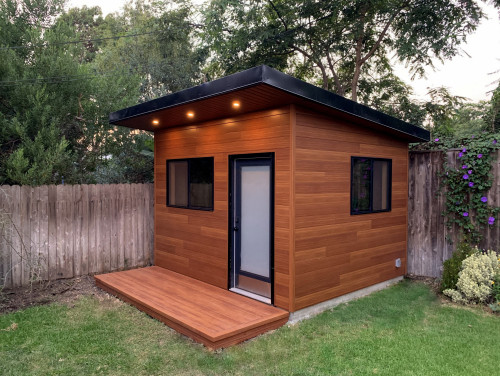If you’ve got rudimentary carpentry skills and sufficient motivation — like a garage so cluttered with gardening equipment and indispensable odds and ends that you dread the thought of trying to squeeze an automobile into it — you may find yourself heading to the lumber yard and preparing to construct a little out-building behind your house. Yes, storage shed — one that serves a multitude of purposes for your every need.

Photo by Royal Building Products – Search shed design ideas
A shed solves the storage needs for outdoor tools and equipment. It is also a great place for work projects that won’t clutter up the garage. It’s a sensible idea for many homeowners. As a way of gaining storage space,
Yes, it is easier then you might think to learn how to build a shed! It’s much easier than tacking a new room onto the house. A skilled builder can complete the project in one day, working solo.
There are many benefits of building your own Storage Shed and first of all your home property value will increase. And if designed properly, a backyard shed can even serve as a potting shed, home office annex or secret clubhouse. Besides, a storage shed can store the lawn and garden’s supplies.
You can buy and assemble a prefabricated storage shed, but it isn’t really a good option. The prefabricated structures don’t have a good look and are limited in durability.
However, whatever your choice is, be sure its construction is carried out in keeping with municipal by-laws, which of course vary from one city to another. Typically if a building is less than 100 square feet a building permit is not required but please contact your local building department.
Building storage sheds or garden sheds takes some important pre-planning. Outdoor storage sheds can be built on a wood frame or concrete foundation. Wooden sheds are easy to build and very affordable.
Choosing a plan should be done carefully, and only after thinking through some basic things like what type of building you desire and what the size requirements are. Plans are available on the Internet and at home improvement stores, and each one provides a comprehensive checklist of materials and a detailed breakdown of the steps involved in construction.
1. Layout:
When you are set for the construction, picking a decent site will be the primary phase. Picking a site that will balance with the home also garden can be better. It is important for you to delineate the perimeter of the shed before you begin construction. Keep in view of the style you pick for the best results. This will allow you to know its exact location right from the start. It will also reduce the risk of mistakes when you put in the foundation.
Shed plans vary on the issue of providing a foundation, or footing, for the structure. Some plans call for the shed to be built solely on wooden skids rather than on a foundation, which leaves the building literally unmoored and easier to move should the occasion ever arise to transport it.
Otherwise, you can use cable tie-downs or wooden posts to anchor the shed. Many plans include either a layer of compactable gravel or poured concrete for a foundation.
2. Foundation:
Structures built in climates where the ground freezes must be protected from frost heave. When soil freezes, the water in the soil expands. This can lift the soil dramatically causing all sorts of structural stresses for those structures built without frost-protected foundations. A frost-protected foundation can be full-length poured concrete footers that extend below the level that frost penetrates or round concrete pads that support treated-lumber posts.
It is recommended concrete block foundation. However, there are two other options: concrete piers or concrete slabs. Before choosing one type of foundation or the other, check on your budget, the type of ground you are building on and the amount of work the option involves.
3. Head Beam and Wood Floor:
As for building materials, it may not come as a surprise to know that you’re going to need a lot of lumber: 2x4s, 4x4s, 2x8s, and many other pieces, for the skids, joists, beams, rafters and every part of the frame. It’s important to use pressure-treated lumber, especially for the floor and the bottom plate of the walls, because such lumber is resistant to decay and insect infestation.
For floors you can use treated plywood sheets and plywood siding for the walls.
4. Shed Walls:
Build the walls one by one on the shed floor, making sure the outside dimensions match those of the floor, less the width of the corner post (4 in. or 100 mm).
If the wall has a window or door, the perimeter of the opening should include a king stud that will support the window or door header. To build the header, attach a 2 × 4 in. (50 mm × 100 mm) to one face of the wall and a second one to the other face. Nail the plywood panels to the walls.
You need help to raise the four walls. To hold the walls up during the erection process, install temporary bracing, diagonally, from top to bottom. It will keep the walls from swaying until such time as you join them together.
5. Building the Roof:
The roofing material may include roof underlay (a type of building paper that goes over the frame), wood sheathing, a durable cladding material such as corrugated iron or asphalt shingles for the exterior, and metal pieces for the drip edges or flashing.
A simple roof frame starts with a single-roof beam, placed above two supports sitting atop the middle of the front and rear wall frames. The four end rafters, two at the front and two at the rear, then slope down from the roof beam just over the edge of the corners, creating the angle of the roof. Several more rafters, each cut at the same angle, must be placed in parallel to fill out the frame. (Keep in mind that roofs can be assembled using prefabricated trusses or homemade rafters.) You can buy prefabricated roof trusses for the roof structure, but cutting simple roof rafters is not that hard. Be sure you cover the exterior walls and roof with overlapping asphalt felt paper before you apply siding or shingles. The felt paper will prevent any wood rot in case a leak develops over time.
6. Door Installation:
Although there are general rules that govern the installation of doors, most manufacturers insist on delivering their products with specific instructions. If you want a special door, give a hard look at smaller overhead garage doors.
7. Windows Installation:
Although you might save some money by building your own windows, these will not offer the same energy efficiency as pre-built windows. It is better to use pre–built windows.
Constructing your own storage shed will be fairly simple, only common woodworking skills are required. The tools necessary can be familiar to most homes. Make sure you will possess the time also the patience.
Expand Your Living Space Building a Shed (howtobuildahouseblog.com)


